
- •CONTENTS
- •PREFACE
- •Content—Benefits for Students
- •Content—Benefits for Instructors
- •Features of the Book for Students and Instructors
- •Supplementary Materials
- •Acknowledgments
- •What Is Hospitality Management?
- •The Manager’s Role in the Hospitality Industry
- •Why Study in a Hospitality Management Program?
- •Planning a Career
- •Employment as an Important Part of Your Education
- •Getting a Job
- •Employment at Graduation
- •The Outlook for Hospitality
- •Summary
- •Managing Change
- •Demand
- •Supply
- •Workforce Diversity
- •The Impact of Labor Scarcity
- •Summary
- •The Varied Field of Food Service
- •The Restaurant Business
- •The Dining Market and the Eating Market
- •Contemporary Popular-Priced Restaurants
- •Restaurants as Part of a Larger Business
- •Summary
- •Restaurant Operations
- •Making a Profit in Food Service Operations
- •Life in the Restaurant Business
- •Summary
- •Chain Restaurant Systems
- •Independent Restaurants
- •Franchised Restaurants
- •Summary
- •Competitive Conditions in Food Service
- •The Marketing Mix
- •Competition with Other Industries
- •Summary
- •Self-Operated Facilities
- •Managed-Services Companies
- •Business and Industry Food Service
- •College and University Food Service
- •Health Care Food Service
- •School and Community Food Service
- •Other Segments
- •Vending
- •Summary
- •Consumer Concerns
- •Food Service and the Environment
- •Technology
- •Summary
- •The Evolution of Lodging
- •Classifications of Hotel Properties
- •Types of Travelers
- •Anticipating Guest Needs in Providing Hospitality Service
- •Service, Service, Service
- •Summary
- •Major Functional Departments
- •The Rooms Side of the House
- •Hotel Food and Beverage Operations
- •Staff and Support Departments
- •Income and Expense Patterns and Control
- •Entry Ports and Careers
- •Summary
- •The Economics of the Hotel Business
- •Dimensions of the Hotel Investment Decision
- •Summary
- •The Conditions of Competition
- •The Marketing Mix in Lodging
- •Product in a Segmented Market
- •Price and Pricing Tactics
- •Place—and Places
- •Promotion: Marketing Communication
- •Summary
- •The Importance of Tourism
- •Travel Trends
- •The Economic Significance of Tourism
- •The United States as an International Tourist Attraction
- •Businesses Serving the Traveler
- •Noneconomic Effects of Tourism
- •Summary
- •Motives and Destinations
- •Mass-Market Tourism
- •Planned Play Environments
- •Casinos and Gaming
- •Urban Entertainment Centers
- •Temporary Attractions: Fairs and Festivals
- •Natural Environments
- •On a Lighter Note. . .
- •Summary
- •Management and Supervision
- •The Economizing Society
- •The Managerial Revolution
- •Management: A Dynamic Force in a Changing Industry
- •What Is Management?
- •Summary
- •Why Study Planning?
- •Planning in Organizations
- •Goal Setting
- •Planning in Operations
- •The Individual Worker as Planner
- •Long-Range Planning Tools
- •Summary
- •Authority: The Cement of Organizations
- •Departmentalization
- •Line and Staff
- •Issues in Organizing
- •Summary
- •Issues in Human-Resources Management
- •Fitting People to Jobs
- •Recruiting
- •Selection and Employment
- •Training
- •Retaining Employees
- •Staff Planning
- •Summary
- •The Importance of Control
- •Control and the “Cybernetic Loop”
- •Tools for Control
- •Summary
- •Leadership as Viewed by Social Scientists
- •Why People Follow
- •Leadership Theories
- •Communication
- •The Elements of Leading and Directing
- •Developing Your Own Leadership Style
- •Summary
- •A Study of Service
- •Rendering Personal Service
- •Managing the Service Transaction
- •How Companies Organize for Service
- •Summary
- •INDEX

342 |
Chapter 11 Forces Shaping the Hotel Business |
The Economics of the Hotel Business
Hotel developers build long-term assets on the basis of relatively short-term cycles. Whereas a hotel’s lifetime is usually 30 or 40 years (and sometimes 100 years or more), the cycle of hotel building is considerably shorter depending on the type of hotel. Figure 11.1 displays the hotel construction timeline by phase. This figure is based on an analysis completed for each of the chain-scale segments for hotels in the construction pipeline between 1994 and 2002.1 Understanding the phase length of the preplanning, planning, final planning, and start-up to completion of construction is important in predicting the room-supply growth of hotel rooms. It is important to note that, between 1994 and 2002, only 25 percent of all projects in the preplanning stage
Chain-scale hotel construction timeline by phase
Independent average |
|
|
|
|
|
|
|
|
|
|
|
|
|
|
|
|
|
|
|
|
|
|
|
|
|
|
|
346 |
|
|
|
586 |
|
|
|
|
119 |
|
484 |
|
|
|
|
|
|||||||||
Economy average |
|
|
|
|
|
|
|
|
|
|
|
|
|
|
|
|
|
|
|
|
||||||
|
|
|
|
|
|
|
|
|
|
|
|
|
|
|
|
|
|
|
|
|
|
|
|
|
|
|
|
529 |
|
|
75 |
194 |
|
344 |
|
|
|
|
|
|
|
|
|
|
|
|
|||||||
|
|
|
|
|
|
|
|
|
|
|
|
|
|
|
|
|
|
|
|
|
|
Preplanning |
|
|
|
|
|
|
|
|
|
|
|
|
|
|
|
|
|
|
|
|
|
|
|
|
|
|
|
|
|
||
|
|
|
|
|
|
|
|
|
|
|
|
|
|
|
|
|
|
|
|
|
|
|
|
|
||
Midscale chains |
|
|
|
|
|
|
|
|
|
|
|
|
|
|
|
|
|
|
|
|
|
Planning |
|
|
|
|
|
|
186 |
|
195 |
391 |
|
|
|
|
|
|
|
|
|
|
|
|
|
|
|
||||||
without F&B average |
|
|
|
|
|
|
|
|
|
|
|
|
|
|
|
Final planning |
|
|
|
|||||||
|
|
|
|
|
|
|
|
|
|
|
|
|
|
|
|
|
|
|
|
|
|
|
|
|||
|
|
64 |
|
|
|
|
|
|
|
|
|
|
|
|
|
|
|
|
|
|
|
|
|
|||
Midscale chains |
|
|
|
|
|
|
|
|
|
|
|
|
|
|
|
|
|
|
|
Start |
|
|
|
|
||
|
|
|
|
|
|
|
|
|
|
|
|
|
|
|
|
|
|
|
|
|
|
|
|
|
||
|
190 |
148 |
|
493 |
|
|
|
|
|
|
|
|
|
|
|
|
|
|
|
|||||||
|
|
|
|
|
|
|
|
|
|
|
|
|
|
|
|
|
|
|
||||||||
with F&B average |
|
|
|
|
|
|
|
|
|
|
|
|
|
|
|
|
|
|
|
|||||||
|
|
|
|
|
|
|
|
|
|
|
|
|
|
|
|
|
|
|
|
|
|
|
|
|
|
|
|
|
20 |
|
|
|
|
|
|
|
|
|
|
|
|
|
|
|
|
|
|
|
|
|
|
|
|
Upscale average |
|
211 |
344 |
|
|
159 |
|
|
|
524 |
|
|
|
|
|
|
|
|
|
|
||||||
Upper-upscale |
|
|
|
|
|
|
|
|
|
|
|
|
|
|
|
|
|
|
|
|
|
|
|
|
|
|
|
|
|
|
|
|
|
|
|
|
|
|
|
|
|
|
|
|
|
|
|
|
|
|
|
|
|
|
425 |
|
544 |
|
|
|
|
115 |
|
|
|
816 |
|
|
|
|
||||||||||
average |
|
|
|
|
|
|
|
|
|
|
|
|
|
|||||||||||||
|
|
|
|
|
|
|
|
|
|
|
|
|
|
|
|
|
|
|
|
|
|
|
|
|
|
|
|
|
200 |
400 |
600 |
|
800 |
1,000 |
1,200 |
1,400 |
1,600 |
1,800 |
2,000 |
||||||||||||||
|
|
|
|
|
|
|
|
|
|
|
|
Number of Days |
|
|
|
|
|
|
||||||||
Figure 11.1
Chain-scale construction timeline by phase. (Source: STR/PPR/F.W. Dodge.)
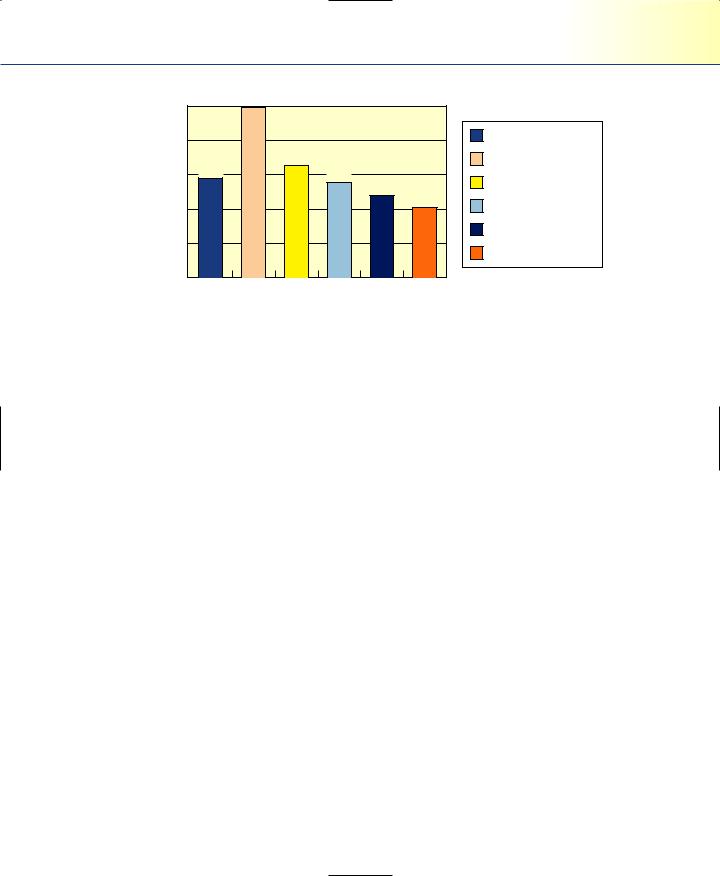
The Economics of the Hotel Business |
343 |
1000 |
|
994 |
|
|
|
800 |
|
|
|
|
655 |
600 |
578 |
553 |
|
|
479 |
400 |
|
407 |
|
|
|
200 |
|
|
0 |
|
|
All hotels
Upper Scale
Upscale
Midscale with F&B
Midscale without F&B
Economy
Figure 11.2
Hotel construction—average days from construction start to opening. (Source: STR/PPR/F.W. Dodge.)
actually were constructed. The percentage of completions increases for each subsequent stage to almost 95 percent of projects in the actual construction stage opening for business at some point in the future (see Figure 11.2). This pipeline ranging over several years results historically in periods of excess capacity followed by demand catching up with supply, followed in turn by periods of more or less frantic building.
Examples of the difficulty in forecasting the supply of hotel rooms can be seen in the more recent changes in estimated growth. Lodging Econometrics (LE) reduced its estimate of added room supply in 2006 resulting in 775 projects with 80,951 rooms. This was a decrease of 4,796 rooms as compared to earlier projections. Estimates were also reduced for 2007 with 1,087 projects having 115,956 rooms planned as supply additions. This represented a decrease of 3,470 rooms from an earlier forecast. Redesign and reengineering requirements were cited as the main reason for the supply reduction relating back to building supplies and construction crews. Although building costs including supplies and labor are easing somewhat, there are still challenges to completing projects on budget and on time. Analysts project that the growing pipeline totals may not have any meaningful impact on industry operations until 2008 when there will be a larger flow of luxury, upscale, and casino projects coming on line.2
The hotel business is cyclical. It is also highly capital intensive, with, depending on the economy, varying sources and levels of capital flowing into the industry. We will consider each of these points—cyclicality, capital intensity, and the impact of capital flows into the industry—in the following sections. In the next chapter, we will consider competition in lodging.
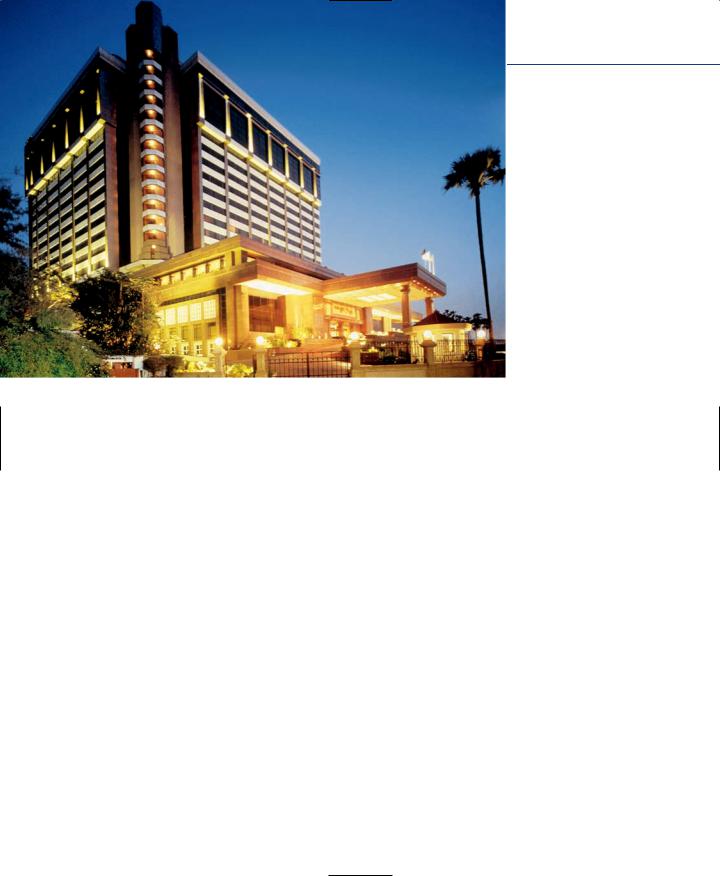
Hotels, large or small, require major investments in land, the physical plant, and equipment. As a result, expansion is very sensitive to economic conditions. (The Regent [Mumbai, India] Courtesy of Carlson Hotels Worldwide.)
A CYCLICAL BUSINESS
The fact that the hotel business is cyclical essentially means one thing: The demand for hotel rooms rises and falls with the business cycle. Generally, the demand for hotel rooms changes direction in direct relation to the economy but lags behind it by several months. This is not surprising, as both business and pleasure travel are easy expenditures to eliminate in a declining economy and to restore when it improves. In any local market, the hotel business is likely to have its own cycle, related to the supply of hotel rooms as well as the demand for them. However, the cycle generally starts with the demand for rooms, potential or actual. Perhaps the easiest way to see this cycle is to work through an imaginary, but quite realistic, example.
An Example of the Hotel Business Cycle. Oldtown, a quiet city of 100,000, has been a stable community with a balanced economy for many years. Not long ago, during a period of general economic expansion, a national company built a large factory complex in Oldtown. The ripple effect from this project spread to the suppliers for the factory complex, as well as to a number of other companies that, when they heard about the factory complex, learned what an attractive site Oldtown was. Employment soared; some people were transferred to Oldtown; others moved there seeking jobs.
Our study now shifts to Major Hotels’ corporate offices, where, in a meeting with the vice presidents of operations and real estate, the vice president for development suggests that Major ought to look into building a hotel in Oldtown. There is immediate agreement to do a preliminary study. Three months later, the preliminary study shows
344

The Economics of the Hotel Business |
345 |
encouraging results, and so several lines of activity are set in motion. A consulting firm is hired to do a formal feasibility study, an architect is hired to do preliminary design work, and informal conversations with Major’s bankers begin. Six more months pass. The results of the consultant’s feasibility study confirm Major’s preliminary study, the preliminary design is a beauty, and everybody agrees this could be a great hotel. The bankers, having looked at the studies and the design, decide to process Major’s loan application quickly. (They have had a surge in deposits and need to get that money into interest-earning loans. They need to lend, just as Major needs to borrow.) Best of all, the ideal location has been found, and negotiations to acquire a site are going well.
At a meeting of Major’s executive committee, a formal proposal to go ahead is presented. The discussion touches briefly on the competition, but everyone quickly agrees that Oldtown’s existing hotels are tired and will be no match for the proposed property. When somebody asks, “Is anybody else going in there?” the answer is, “A few people have been nosing around, but there’s nothing firm as far as we can tell.” Everyone agrees that it is time to purchase the site and sign a design contract with the architect. Because this is a meeting, everybody’s commitment is a public matter.
The same series of events is taking place at Magnificent Hotels, LowCost Lodges, Supersuites, and a couple of other companies. However, because each company keeps things fairly quiet until everything is settled, there are only vague rumors that others are also interested in Oldtown.
Finally, 18 months after the first vice presidential meeting at Major, the company announces that a 300-room hotel will be built in Oldtown, and the groundbreaking is set two weeks hence. The story is front-page news. Over the next six months, similar announcements from Magnificent, LowCost, and Supersuites make the front page, too.
At Major, these other companies’ announcements cause quite a stir. At a meeting of the executive committee, they all shake their heads and agree that those other companies are crazy; they have no sense at all in overbuilding like this. One very junior vice president who is sitting in raises the possibility that Major should abandon the project, but he is quickly shouted down. Thousands of dollars have already been spent on feasibility studies and architectural work, a site has been purchased, and contracts have been signed for construction. “Besides,” says the financial vice president, “what would our banks say if we pulled out now? Do you think we’d get another loan commitment as easily next time?” Because everybody has agreed to the project publicly, for any to admit that he or she was wrong would also be publicly embarrassing.
Eighteen months later, Major’s beautiful new property opens, and the general manager hands the following situation report to the vice president of operations:
Within four blocks of my office, there are a thousand rooms under construction. Everyplace my sales staff goes, they trip over our competitors’ people. Magnificent is slashing its convention rates for next year, LowCost has announced a salespersons’

346 |
Chapter 11 Forces Shaping the Hotel Business |
discount when its hotel opens next month, and Supersuites is offering free cocktail parties every evening. I think we will do all right after the first couple of years because our operation is going to be stronger and of better quality, but don’t expect much for our first two or three years until we are established. There are no further announcements of lodging construction in Oldtown.
We have spent quite a bit of time looking at this cycle of events to illustrate the significance of factors such as the complexity of the decision to build a hotel, the lead time required, the preliminary expenditures, and the public corporate and individual commitment to the decision. This cycle shows that an increase in demand can set off a series of events that usually cannot be stopped even when it becomes clear that the market is or will be overbuilt.
In other markets, it takes years for the demand to catch up with the overbuilding. In some, however, the demand keeps increasing, and in three to five years another round of building starts, this time fueled by all the old faces plus some new ones—for those who didn’t get in the first time. All have a need to be represented in the growth market.
Our example was of a local market, but this is usually part of a larger, national market. Different local events related to a general national period of prosperity set off building booms in many local markets because demand for hotel rooms is closely related to general economic conditions. When the national economy turns down, so does the hotel business. Hotel building tends to come in waves or cycles that end, much to everybody’s surprise, in an overbuilt industry.
HOTEL CYCLES AND FINANCIAL PERFORMANCE
In an ideal world for hotels, the demand for rooms would equal or exceed the supply of rooms. Pricing of rooms could therefore be maximized, resulting in higher average room rates. In reality, however, supply and demand cannot be precisely calculated or predicted. As discussed in Chapter 13 (Global Hospitality Note 13.1– Public Anxiety and the Travel Industry), unexpected catastrophic events have affected the hospitality industry as well as other segments of our lives. The tragedies of September 11 had a significant negative impact on the number of people traveling, subsequently greatly reducing the demand for hotel rooms. The operating profit for the average U.S. hotel dropped 19.4 percent in 2001. This was followed by a 9.6 percent drop in profits for 2002, marking the first two-year decline in hotel profitability since 1982 to 1983.3 As evidence of the cyclical nature of the lodging industry, consider that 2000 was the most profitable year in the lodging industry, grossing $24.0 billion in pretax profits. This figure was 9 percent more than in 1999 and double the amount earned in 1996. Total industry revenue rose from $62.8 billion in 1990 to $112.1 billion in 2000. In 1990, the

INDUSTRY PRACTICE NOTE 11.1
Hotel Operations After Katrina
Smith Travel Research conducted an analysis of the Gulf Coast region one year after Hurricane Katrina, compared to prior to the devastating natural disaster that occurred on August 29, 2005. In June 2005, there were 723 hotels with 79,500 rooms in Louisiana. After Katrina, the room count in that state dropped to 53,000—a 33-percent drop in inventory. In June 2006, the statewide room count was back to 69,500, but was still 13 percent below the prestorm room count. New Orleans, of course, experienced the most severe impact with almost 70 percent of its room inventory lost because of the devastation. Of the 38,322 rooms, only 11,900 remained. In June 2006, the inventory was up to 28,400 rooms but still 26 percent below the pre-August 29 number. The reduction in rooms available and rooms sold led to an increase in occupancy through June 2006 in New Orleans. For the first six months of 2006, occupancy increased 2.2 percent to 71.2 percent with an average rate of $128.63.
In New Orleans, the largest number of lost rooms was in the Central Business District/French Quarter. Of the 24,700 existing rooms in June 2005, only 5,600 rooms were open for business in September after Katrina. In June 2006, there were approximately 19,500 rooms available.
In the Biloxi/Gulfport area, two-thirds of the hotel rooms were lost from Katrina. The inventory dropped from 16,000 rooms to about 5,000. As of June 2006, this area was still 58 percent below normal supply. The average daily rate (ADR) had increased to $93.34 by June 2006 with occupancy (considering the reduced inventory) of 87.1 percent.
Source: J. Freitag, “Roads to Recovery—Revisiting the Gulf Coast One Year After Katrina,” Lodging Magazine, http://www.lodging magazine.com/index.cfm?fm=Article.Detail&aid=110
industry suffered a $5.7 billion loss during a recessionary period complicated by Desert Storm and the Persian Gulf War in the Middle East. Total industry revenue declined in 2002 to $102.6 billion from $103.5 billion in 2001.4
The domestic recovery following September 11 started in the third quarter of 2003. The year of 2005 showed profits in the hotel industry of 15.5 percent which was the greatest increase since 1996. Except for the Louisiana and Mississippi areas hit by Hurricane Katrina in the early fall of 2005, hotel occupancies for 2005 equaled or exceeded their long-term averages with strong gains in average room rates. For 2006 there was a 7.5 percent growth in total revenue with a 4.1 percent total revenue increase for 2007 with profit gains of 14.9 percent and 7.0 percent respectively. This equates to U.S. hotels achieving a profit of almost $14,800 per-available-room in 2006 and $15,800 in 2007. This figure slightly exceeds the $15,674 profit level of 2000 but, in real dollars, still puts the hotels about 20 percent behind where they were in that year.5 Industry Practice Note 11.1 discusses the impact of Katrina on the lodging industry of the Gulf Coast of Louisiana and Mississippi.
347

348 |
Chapter 11 Forces Shaping the Hotel Business |
One factor that is typically considered in analyzing the financial performance and predictions of the hotel industry is the inventory of available hotel rooms. During the hotel industry crisis of the late 1980s/early 1990s, clearly hotel development and financing communities contributed to the catastrophic impact with the illogical growth of the 1980s in which the hotel market was excessively overbuilt. Until 1986, the growth was driven, to some degree, by tax considerations, which developers seemed to think made profit a secondary consideration. Another factor explaining hotel growth in the face of losses in operations (between 1982 and 1993, the lodging industry lost a staggering total of $33 billion) was the increasing emphasis on segmented room products (the industry has never been segmented to the extent that it is now). Although the market as a whole in a city might have enough rooms to satisfy demand, if there was a shortage of one specific category—say, limited service or all-suites—then developers in that category saw an opportunity and new rooms were built to satisfy that specialized need. In some cases, rooms were built where there was no shortage of any kind but simply because of competitive pressure for major brands to be represented in an important market. In the late 1980s and early 1990s, property values fell far below replacement costs. Part of the meaning of a cyclical market is that there are good times as well as bad (expressed in terms of profit). The industry broke even in 1992 and had a profitable year in 1993, leading up to the best industry year in 2000. Overbuilding has not, however, been identified as a factor in the downturn starting in 2001. Depressed demand (resulting in lower occupancy rates) and collapsed rates (lower average room rates) were due to a combination of a depressed economy, terrorism, war, travel complications, and SARS.6
With better economic times becoming evident in 2003, one might expect a surge to follow in hotel development. Analysts, however, unlike the late 1980s and early 1990s, see factors limiting rapid hotel supply growth. These factors include escalating land and construction prices that are not expected to become more reasonable in the foreseeable future. Construction costs were even further impacted with Hurricane Katrina particularly with lumber and wood-related products.7
The hotel industry throughout the downward business cycle of 2001 through 2003 showed that good management can make a significant difference in maximizing profitability with reduced revenue. Only a couple of midsized companies sought protection of bankruptcy laws since 2001. PKF Hospitality Research indicated that more than 80 percent of hotels were profitable at the unit level in 2002. Although hotel revenues were down after the peak in 2000, expenses—particularly big ones such as labor and interest rates—were also down. With this equation, it was possible that hotel income increased as revenues declined.8 So while profits fell for hotels, according to the Hospitality Research Group of PKF Consulting, the average 2002 profit for properties was 27.5 percent—almost two full percentage points greater than the 25.6 percent average

The Economics of the Hotel Business |
349 |
margin earned by U.S. hotels from 1960 to 2001. Subsequently, in 2003, buyers were willing to pay competitively for good hotel properties.9
The hotel industry, during the leaner times following September 11, learned how to operate more efficiently and these lessons will have long-term benefits. For example, in 2005, PKF Hospitality Research found in their sample of hotels that an 8.8 percent increase in total revenue was turned into a 15.5 percent increase in profits. According to this source, that was one of the largest annual gains in unit-level profitability in the past 25 years. There was some variance based on the hotel categories but all hotel segments had gains in total revenue in 2005. Limited-service hotels achieved the greatest increase in revenue (10.3 percent) in 2005 while full-service hotels achieved the greatest increase in profitability (19.3 percent) for the same time period. Convention hotels, while not faring quite as well, still had a 7.8 percent gain in revenue and a 12.2 percent increase in profits.10
For U.S. hotel properties in 2005, there was a 6.5 percent increase in total operating costs. The 5.1 percent increase in labor and related costs contributed largely to this total. For the second consecutive year, the increase in employee benefits overshadowed the increase in wages and salaries. Employee benefits increased by 6.4 percent compared to a 4.6 percent increase in salaries and wages. Employee benefits include payroll taxes, payroll-related insurance, subsidized employee insurance (the amount the hotel pays for the particular benefit plan to offset the employee-paid premiums for coverage such as medical, dental and life insurance), retirement plans and employee meals (again that are typically subsidized to offer low-cost or even free meals to employees during their work shifts). Some of these benefits are mandated by government on the federal, state, and local levels. Another reason for the increase in this area is that benefit packages are an important employee recruiting and retention tool. Regarding other operating expenses, the rooms department experienced the single largest increase in 2005 as compared to any revenue-generating department. Part of the increase in the rooms division reflects the higher occupancy (more guests for whom to provide supplies, clean rooms and staff departments). Along with this is the presence of amenity creep—a trend that has been steadily growing in the hotel industry for several years. Guests increasingly expect more in a guest room from free WiFi to an assortment of bathroom products (no longer just shampoo and soap but conditioners, body lotions, shoe mitts, sewing kits, shower caps, etc.) and enhanced bedding.11
Additional increases in hotel expenses for 2005 are noteworthy of separate mention. In that year management fees increased by 8.9 percent and franchise fees increased by 9.8 percent. These fees are usually based on a percentage of revenue and reflect the sizable revenue increases for that year. Another big contributor to hotel overhead was utility costs. In 2005, hotel utility costs increased by 13.6 percent, which made these

350
|
T |
ABLE |
11.1 |
|
|
|
|
|
expenses the single largest increase |
||||
|
|
|
|
|
|
on the financial statement. The pre- |
|||||||
|
|
|
|
|
|
|
|
|
|
|
|
|
|
|
|
|
|
|
|
|
|
PERCENTAGE OF |
AVERAGE ROOM |
||||
|
|
|
|
|
|
|
|
diction is that utility expenses will |
|||||
|
|
|
YEAR |
OCCUPANCY |
|
RATE |
|||||||
|
|
|
|
continue to remain high or climb |
|||||||||
|
|
|
|
|
|
|
|
|
|
|
|
|
|
|
|
|
|
2001 |
|
|
|
65.4% |
$ |
|
115.51 |
to even higher levels.12 |
|
|
|
|
|
|
|
|
|
While the controlling of over- |
|||||
|
|
|
|
2002 |
|
|
|
64.3% |
$ |
|
105.96 |
||
|
|
|
|
|
|
|
|
head and expenses is vital in order |
|||||
|
|
|
|
2003 |
|
|
|
65.2% |
$ |
|
107.28 |
||
|
|
|
|
|
|
|
|
to maximize profitability in any ho- |
|||||
|
|
|
|
2004 |
|
|
|
69.4% |
$ |
|
117.39 |
||
|
|
|
|
|
|
|
|
tel operation, the key drivers in the |
|||||
|
|
|
|
2005 |
|
|
|
71.4% |
$ |
|
126.12 |
||
|
|
|
|
|
|
|
|
profitability of a lodging property |
|||||
|
|
|
|
|
|
|
|
|
|
|
|
|
|
|
|
|
|
|
|
|
|
|
|
|
|
|
are occupancy and average room |
|
|
|
|
|
|
|
|
rate. A property with a high occupancy can still lose money with low room rates. High |
|||||
|
|
|
|
|
|
|
|
room rates, however, are not totally the answer if there is insufficient occupancy. Ob- |
|||||
|
|
|
|
|
|
|
|
viously, management skill in keeping overhead costs in line is consistently important |
|||||
|
|
|
|
|
|
|
|
to maximize the hotel’s profitability. |
|
||||
|
|
|
|
|
|
|
|
The average U.S. occupancy rate was the lowest in 31 years in 2002 at 64.3 per- |
|||||
|
|
|
|
|
|
|
|
cent with an average room rate of $105.96. This represents a drop of $9.55 from the |
|||||
|
|
|
|
|
|
|
|
previous year. In comparison, for 2005, the overall percentage of occupancy was 71.4 |
|||||
|
|
|
|
|
|
|
|
percent with an average daily room rate of $126.12. Table 11.1 shows the average oc- |
|||||
|
|
|
|
|
|
|
|
cupancies for hotels in the United States from 2001 to 2005 and average room rates |
|||||
|
|
|
|
|
|
|
|
during that same time period.13 |
|
||||
REVPAR
A well-established measure over the years in evaluating hotel performance has been revenue per available rooms (RevPAR). RevPAR, resulting from the rental of guest rooms, is the key source of revenue for the lodging industry. A logical question would be: What drives profitability greater in RevPAR growth—occupancy or room rate? According to PKF Hospitality Research, when RevPAR growth is dominated by occupancy increases there are also costs in servicing the extra rooms and guests. Therefore, the gains in profit are less. When RevPAR growth is driven by increases in the average daily rate (ADR), “economies of scale allow for a greater percentage of the rooms revenue gain to drop to the bottom line.”14 During times of intense competition (as when business drops and every hotel is truly fighting for survival), properties can create an extremely detrimental situation in lowering room rates to the point that occupancy cannot help pull out the needed profitability.
International Hotel Operations. In an analysis of 2006 European hotel operations, London achieved the highest revenue per available room (RevPAR) for that

The Economics of the Hotel Business |
351 |
year. The RevPAR of EUR166.63 was up 18.49 percent from 2005. These results were driven by an average room rate (ARR) of €205.30 and a year-end occupancy of 81.7 percent. Moscow was second in the European market with RevPAR of €161.78, an average room rate of €222.53, which equates to an increase of 15.1 percent over 2005. Global figures for 2006 showed improvement worldwide with RevPAR growth in Europe up by 11.61 percent, the United States was up by 7.5 percent, and there was a 20.12 percent increase in Asia Pacific. When including the Middle East markets with Europe, the third in absolute RevPAR was Dubai (€156.03), followed by Paris (€152.36) and Amsterdam (€104.27).15
HOTELS AS REAL ESTATE
Hotels may be built because an area or community development needs the property; that is, the hotel may be necessary to a larger project. At times, hotels have been built in areas slated for mega-events, such as a winter or summer Olympics. A saying in the industry is, “You don’t build a church just for Easter Sunday.” Applied to the hotel industry, that is interpreted to mean that it may not be wise to build a hotel just for a three-week sell-out event. A longer-term concern would be whether the travel industry (leisure and business) is going to support the addition of another hotel property in that particular area. Another reason supporting investing in hotels could be that the underlying value of the real estate and its appreciation are a more important consideration to the investors than the profitability of the hotel. For example, a number of foreign investors in North America have apparently, from time to time, been willing to invest money in hotel properties for their longer-term appreciation and as a safe haven for their funds.
Hotel pricing can make hotel real estate more attractive than other real estate, particularly in inflationary times, because of the ability to increase rates literally overnight. The ability to increase revenues is not as flexible in other real-estate projects, in which rents are generally fixed by long-term leases. As a result, hotels, although they have a higher risk than other real estate, find favor with investors, especially during the optimistic growth phase of the hotel industry cycle.
Hotel companies are highly active not only as operators and franchisors of hotels but as real-estate developers. Marriott, for instance, sustains their growth in part by buying, developing, and then reselling land and hotel properties. Indeed, such companies have a real interest in continuing expansion of their brands to gain a greater share of the market and to ensure that their brands have a presence in the widest number of local markets. Naturally, they also want to gain the profits from development. These motives to expand, however sensible they may be from the individual company’s vantage point, often lead to the “overbuilding” that has been such a bane to the hotel business
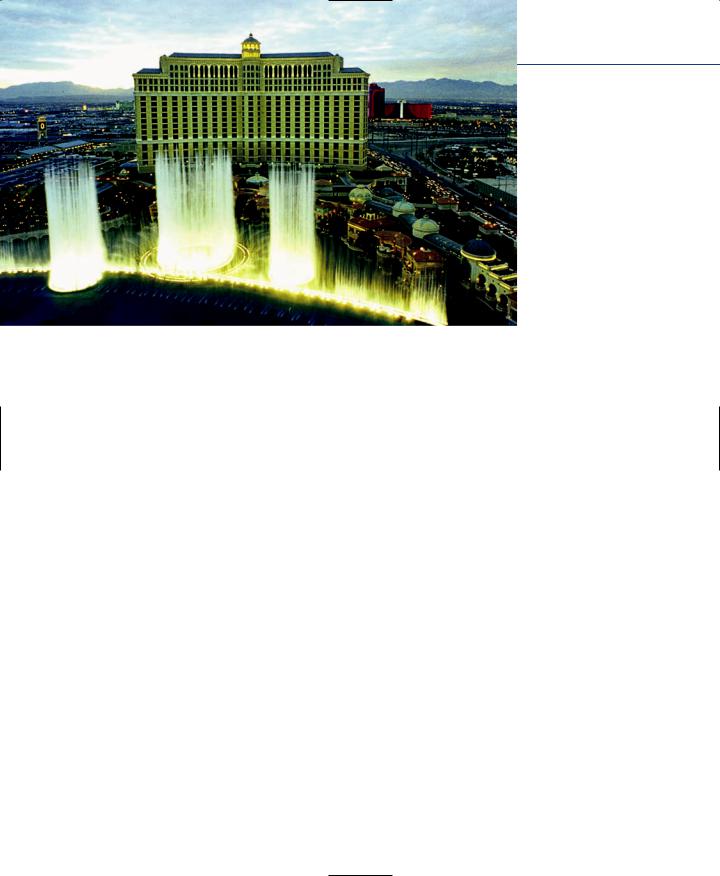
Bellagio Las Vegas cost $1.6 billion to build, opening in 1998. (Courtesy of Las Vegas Convention and Visitors Authority.)
generally. Industry Practice 11.2 discusses a growing concept in hotel real estate—mixed- use developments including a special section on condo-hotels. Hotel investments reached $21 billion in 2005, which was 63 percent higher than the previous year. At least $20 billion is predicted in hotel investments in 2006.16 Industry Practice Note 11.3 describes the process of a real estate transaction.
INTERNATIONAL HOTEL DEVELOPMENT
Regarding international hotels, the focus for new hotel development is in Asia. According to Lodging Econometrics (LE), Wall Street considers the “growing offshore development to be a significant component of their analysis of U.S.-based hotel companies and real estate investment groups.” As of mid-2006, there were 386 “actively pursued” construction projects planned for Asia with 111,285 rooms. China leads this movement with 188 hotels in the pipeline representing 48 percent of all developments in Asia. The majority of these projects (134 out of 188) are fouror five-star hotels. China is projected to be the largest tourist destination in the world by 2020. The 2008 Olympic Games in Beijing is adding momentum to the development trend along with Shanghai, a major world-class financial center. Macau, a major gaming destination, and the nearby resorts of Taipa and Coloane, are contributing to the pipeline numbers with the average size property exceeding 700 rooms in these locations. India is also a major location for new hotels with 44 percent of the new properties planned near outsourcing office centers in the cities of Bangalore, Chennai, Hyderabad, and Mumbai. Thailand is
352

INDUSTRY PRACTICE NOTE 11.2
Condo-Hotels as Mixed-Use Developments
With the aging of the baby boomers and the realization that many from this era prefer luxury vacationliving, comes the proliferation of the condo-hotel. While condo-hotels have been around for many years, these developments were traditionally found in the luxury-resort locations of Florida, Las Vegas, and the Caribbean. Now the condo-hotel concept can be found in numerous locations worldwide. Traditional hotels have started adding the condominium units to properties, thus serving both transient guests and condo owners. Buyers of the condo unit are not burdened with any upkeep issues including furnishings or amenities. The owner of the condo unit in the condo-hotel developments simply has to reserve his or her room and show up to enjoy the services the hotel has to offer.
Condo-hotels do present some operational challenges, however, particularly when it involves booking those rooms for nonowner use. Because condo owners are not using their rooms at the same time, coordinating with blocking section in advance for group or convention use to maximize revenue can sometimes be difficult. There are different ways to structure the condo owners’ use of their unit, which is addressed in the contract with the owner. Remington Hotels manages a condo-hotel in Orlando, Florida. Owners who have elected to put their rooms into the hotel’s rental pool for transient use are given a calendar asking them, in advance, to plan when they wish to use the room. The hotel’s transient business is then planned around the owners’ calendars.
Another area of potential conflict concerns condo furnishings. Most condo-hotels do not allow owners to change the in-room furnishings. Hotels need a consistent, uniform room because this helps keep the repair and replacement charges in check.
Despite the challenges, real estate experts say that the condo-hotel option will be attractive, particularly to the baby boom generation.
Source: Rob Heyman, “Home Sweet Home—Dealing with the operational side of today’s mixed-use properties.” Lodging, http://wwwlodgingmagazine.com/index/cfm?fm=CurrentIssue.operations
the third-largest area in Asian hotel development. Many of these projects are part of the redevelopment process following the tsunami of December 2004.17
PRIVATE EQUITY INVESTMENTS
Private equity firms accounted for 44 percent of hospitality transactions in 2005 and were the single largest group of investments. Publicly held companies made up the second largest portion of transactions. Private equity is a broad term that can include individuals or families (such as the Pritzker family, who have owned Hyatt Corporation for over 50 years) to pension funds or university/foundation endowments. Pension
353

INDUSTRY PRACTICE NOTE 11.3
The Elements of the Hotel Real-Estate Deal
A seven-year process was involved in the development of the $300-million, 950-room JW Marriott Desert Ridge Resort & Spa located in suburban Phoenix, Arizona. The hotel, which opened in November of 2002, had more than 450,000 room nights on the books from the start, with reservations booked into 2009. JW Marriott Desert Ridge Resort & Spa is the largest resort in Arizona.
The first step in the development of this resort took place in the mid-1990s. In analyzing the market, Marriott International saw that Arizona was lacking facilities for large-group business. According to JW Marriott, Jr., Marriott’s chairman and CEO, “I’m a strong proponent of the big-box hotel. If you build them bigger and better than the competition, people will come.”
The initial step was followed by a series of focus group meetings. The objectives of these meetings included testing the concept and creating a vision for the property. Information from these meetings helped determine that a hotel was needed with between 1,000 and 1,200 rooms. In addition, adequate meeting space was essential—in the area of 100,000 square feet. In keeping with the resort setting, multiple golf courses were essential, as was a major spa.
With these parameters defined, the development team went to work looking for the right city in Arizona as a location. The choice of Phoenix was facilitated by the fact that one of Phoenix’s civic goals was to make the city a major convention destination. At this point, Marriott began discussions with Northeast Phoenix Partners, who controlled 6,000 acres of land. The master plan project was called Desert Ridge. Talks with the department of transportation were also initiated to clarify plans for expanding the freeway system serving that area of town. By 1999, Marriott acquired an existing golf course and a lease interest in the land for the hotel and a second golf course. Discussions continued over the next several months to determine the hotel’s number of rooms, height, traffic flow, and other details.
By early 2000, almost 90 percent of the property design was complete. Marriott approached CNL Hospitality Corp. CNL became a capital partner through equity investments, including a real estate investment trust (REIT). Other financing included a private placement to high-net-worth investors (which raised $28.5 million), the addition to several major institutional investors, and a mezzanine loan provided by Marriott. Marriott maintained a minority equity interest.
Construction started in early 2001. The second golf course opened in February 2002, with the hotel opening the following November. Seven years had transpired since the project’s conception. The resort contains 100,000 square feet of indoor meeting space and 100,000 square feet of dedicated outdoor meeting and gathering areas.
Source: From Ed Watkins, “Anatomy of a Big Deal,” Lodging Hospitality, July 1, 2003, p. 26.
funds have made a sizable impact with their investments in hotel properties including California’s teacher pension fund.
Private equity firms manage pooled money to acquire properties and oversee investments. Examples of large-scale private equity companies are the Blackstone Group,
354

The Economics of the Hotel Business |
355 |
RLJ Development and Colony Capital. The Blackstone Group had the second and third largest portfolio acquisitions in 2006 with the LaQuinta Corporation and MeriStar Hospitality. These transactions totaled $6 billion. Fueling the interest of private equity investments in hospitality has been the increase in travel by both leisure and business segments. Supply of hotel rooms remains limited because of higher construction costs and land prices. The underperformance of other investment options such as commercial, multifamily, and retail real estate has also attracted the private equity firms to the hotel industry. Private equity firms are motivated by high-yield returns and therefore tend to have shorter holding periods of typically two to four years. For example, the Blackstone Group bought Wyndam Hotels and sold the name, franchising, and management company to Cendant (which is now Wyndam Worldwide) in less than a year.18
THE SECURITIZATION OF THE HOTEL INDUSTRY
The “securitization” of the hotel industry refers to the influx of funds into the industry in return for equity and debt securities issued by publicly traded hospitality companies.19 There have always been the Marriotts, the Sheratons, the Hiltons, companies that obtained most of their financing from public markets.20 However, in the 1990s expansion of financing vehicles emerged that were relatively new to the hotel industry, such as commercial mortgage-backed securities (CMBSs) and realestate investment trusts (REITs). These forms of financing led to an unprecedented growth in the funds from public markets invested in lodging. To understand this development, we will briefly consider these forms of debt and equity capital. As a point of clarification, when speaking of debt, we will be referring to borrowed funds such as mortgages, bonds, debentures, and the like. We will use the term equity to refer to ownership, here in the form of stock sold to individual and institutional investors. In 2005, publicly held companies made up the second largest group of transactions. Of these, REITs were responsible for 20 percent of industry investments.21
Debt Investments and Commercial Mortgage-Backed Securities. For many years, the primary sources from which companies borrowed for purposes of hotel construction were limited to banks and insurance companies—except for a handful of public companies. There are now additional sources of debt for hotel construction. Hotel developers can access such funding through conduit lenders that we will discuss in a moment. This wider availability of loans, however, poses some real questions about the dangers of overbuilding. A commercial mortgage-backed security (CMBS) is “a security, often a bond rated by bond agencies, backed by a pool of commercial mortgages” and the future income those mortgages will generate from payments of interest and principal.22
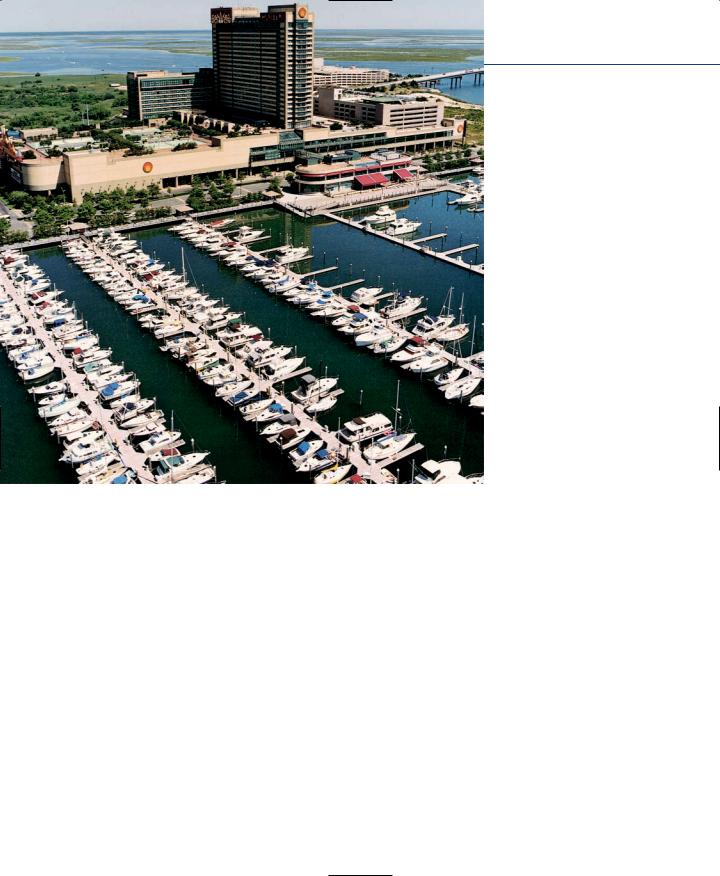
Well-financed companies are especially well suited to carry out large complex hotel development. (Courtesy of Trump’s Castle.)
CMBS debt is assembled by conduit lenders who use their own funds to lend initially to the borrower. When a sufficient dollar amount has been assembled, the mortgages are “packaged” and sold to the public and institutional investors. There are specialized firms that engage in this business. Banks, brokerage firms, and other financial institutions also have divisions that act as conduit lenders. The CMBS market was one of the best sources of financing for hotel owners post-September 11. With cor- porate-bond markets turning away from hotels and portfolio lenders reluctant to take concentrated risks in hotel assets, the CMBS market found that, if properly sized and priced, hotels can produce profits.
Other Sources of Debt Financing. Owners may find that they can obtain at most a 65 percent first mortgage on a property. To decrease the amount of their own funds required, they resort to what is called mezzanine financing.23 Mezzanine financing, sometimes referred to as gap financing, “bridges the gap between the first mortgage and the amount of equity committed to a project.”24
356

The Economics of the Hotel Business |
357 |
It is very much like a second mortgage. Mezzanine financing is not secured by a mortgage—or else is subordinated to a first mortgage. It carries a higher interest rate than mortgage financing because of its higher risk. In the previous example, however, if the owners could obtain 65 percent first-mortgage financing and another 20 percent mezzanine financing, the amount of their own capital required to build the property would be reduced from 35 percent to 15 percent of the cost, effectively increasing their power to expand. The primary advantage of mezzanine debt is that it provides additional capital while allowing current ownership to maintain control of the asset without having to take on additional equity partners. The cost of these funds can range from 15 to 20 percent interest with threeto seven-year terms. Mezzanine funding does add another debt obligation to the hotel. Overall leverage is thereby increased as well as downside risks are elevated. Even with these added risks considered, it can be advantageous, because long-term mezzanine funding is less expensive than having equity partners if a project is successful.25
Sources of Equity Investment. Principal sources of equity investment in lodging include real-estate investment trusts (REITs), initial public offerings (IPOs), and secondary stock offerings.
Real-estate investment trusts. Real-estate investment trusts (REITs) are companies that own, and in most cases, operate income-producing real estate. Real estate may include residential properties, shopping centers, offices, lodging/resort properties and malls, for example. While some REITs finance real estate, others directly own and/or operate income-producing real estate. To be a REIT, a company must distribute at least 90 percent of its taxable income to its shareholders annually in the form of dividends. The growth of REITs has been so significant that Standard & Poors added REITs to its major indexes including the S&P 500.26
REITs do offer benefits over merely buying and selling real estate, including hotel properties, individually. One of the advantages of this type of investing is that it helps reduce the risks of doing this individually while reaping the benefit of income generated from multiple properties. If one property is doing poorly, it can be offset by others that could be more profitable. REITs, in general, returned 34 percent in 2006, on average. For the five years through December 2006, the annualized return was 23.2 percent. By contrast, the Standard & Poor’s 500-stock index returned 15.8 percent in 2005 and 6.2 percent, annualized, over the 2002–2006 span. Industry experts predicted that many hotel companies, REITs and non-REITs, will do well in 2007 as demand for hotel rooms outpaces supply.27
An example of a lodging REIT is FelCor Lodging Trust (NYSE:FCH), which acquires, renovates, redevelops and rebrands hotels. FelCor owns approximately 115 consolidated hotels in 28 states and Canada with a market cap of $3.3 billion. This

358Chapter 11 Forces Shaping the Hotel Business
company has formed strategic alliances with three leading brand owners: Hilton Hotels Corporation, Starwood Hotels and Resorts, and InterContinental Hotels Group. Their portfolio includes Embassy Suites Hotels, Doubletree, Sheraton, Westin and Holiday Inn.28
Other publicly held companies. As we noted earlier, companies such as Hilton and Marriott have long been publicly held, that is, owned by stockholders whose shares are publicly traded. These and other publicly traded corporations are often referred to as C corps to distinguish them from REITs, which are also corporations.29 (Note: Blackstone/Group purchased Hilton in the fourth quarter of 2007.)
Host Marriott was initially created in 1993 in the split of Marriott in which Host Marriott became owner of lodging real estate and operator of airport terminal concession businesses and Marriott International was the manager of lodging and contractservice businesses. Later, Marriott created two separate companies, with one focused on lodging real estate. In 1999, Host Marriott reorganized to qualify as a real-estate investment trust. Based in Bethesda, Maryland, Host Marriott typically buys conservative fourand five-star hotels in major urban areas and owns properties that carry the brands of Marriott, Ritz-Carlton, Renaissance, Four Seasons, and Hyatt. Starting in 2003 Host Marriott became very active in selling and buying properties. One purchase in 2003 was the Hyatt Regency Maui Resort and Spa in Hawaii, purchased for $321 million. By August of 2003, the REIT had already sold four hotels, with plans to see several more hotels bringing in proceeds of $100 million to $250 million. Proceeds were planned to repay debt, invest in their current portfolio, or acquire additional hotels.30
Late in 2005, Host Marriott Corporation announced an agreement to purchase 38 hotels. The seller was Starwood Hotels & Resorts and the price tag was $4.1 billion for the properties located around the world. With the increased diversity, Host Marriott changed its name to Host Hotels & Resorts and became the world’s largest lodging REIT and one of the largest owners of high-end hotels and resorts with 128 properties encompassing 67,000 rooms.31
Secondary offerings. When a company that is already publicly traded issues additional shares, they are referred to as a secondary offering. From 1991 to 1997, REITs and C corps raised $11.5 billion through secondary offerings. Including both debt and equity, that amount reached nearly $27 billion during the seven-year period, the vast majority of it in the last four years of that period.
Equity investment and joint ventures. More investors are turning to hotels and real estate as stocks and mutual funds have not provided meaningful returns. This has resulted in a great deal of capital seeking hotel investments often from nontraditional hotel investors. Instead of selling the asset outright, an option is to sell a portion of a hotel. This capital can then be used for expansion, renovations, or new projects. There are benefits for the new investors in enjoying the current yield while entering a new industry, as long as skilled operators are involved.32

The Economics of the Hotel Business |
359 |
Public funding. Public funding refers to public tax dollars. The use of public tax dollars particularly in the building of convention center hotels has been a contentious issue for some time. Typically supported by city leaders, investment bankers, convention bureaus, meeting planners, and some hotel management companies, many hotel owners feel that use of public funding to compete with their own hotels is unfair. These hotel owners contribute to the pool of public funding with the bed, corporate, and other taxes they pay to the city, county, and state. In essence, they are contributing to underwrite or subsidize a hotel to compete with their own. Advocates of such funding emphasize that such projects can infuse new vitality and revenue into a city’s convention market, thereby benefiting more than the convention center hotel. With funding as the key, the average building price of $175,000 to $225,000 per room cannot be handled by the private sector without some type of assistance from the government. An example of such funding is with the 1,100-room Hyatt Regency Denver at the Convention Center. Tax-exempt revenue bonds totaling $350 million were secured for this project; otherwise, it was unlikely to become a reality.33
Securitization and Competition. Although we will defer most of our discussion of competition in the lodging business to the next chapter, this is a good point at which to consider the impact of the huge influx of capital on the hotel business and its competitive structure. When more funds flow into the industry, it becomes easier to build more rooms, increasing competition. When capital has been more readily available and, in a rising stock market, effectively less costly, mergers and acquisitions (M&A) activity has increased as well.
Real-estate investment trusts have been active players in the mergers and acquisitions field, too. The financial power of the REITs is substantial. Because of their ready access to the public capital markets, they can manage large acquisitions with new stock issues. The stock either can be used to raise cash toward the purchase price or can be given to the seller as part of the purchase price. In effect, they have the power to virtually coin money—as long as their stock market value holds up.
An interesting example of financial muscle is the purchase by Starwood Lodging of two leading upscale international chains within a two-month period. In early September of 1997, Starwood purchased Westin Hotels and Resorts for just under $1.6 billion. Then, in October, the company announced the purchase of ITT Sheraton for a price of $14.6 billion.34
Almost overnight, this company jumped from being a minor player in the industry to becoming a Fortune 500 company with more than 700 hotels worldwide. The company included the well-known brands of Sheraton, Westin, W Hotels, the Luxury Connection, Four Points by Sheraton, as well as the top brand of St. Regis.35

360 |
Chapter 11 Forces Shaping the Hotel Business |
One prominent acquisition that took place post-September 11 was the acquisition of Candlewood Suites by InterContinental Hotels Group PLC. Candlewood Suites was the sixth brand in the InterContinental portfolio. Others, in addition to the InterContinental brand, include Holiday Inn, Holiday Inn Express, Crowne Plaza, and Staybridge Suites & Resorts. The acquisition positions InterContinental in two tiers of the extendedstay hotel market. Staybridge Suites would be in the upscale tier, with room rates that average about $30 more per night than rooms at Candlewood.36
Cendant Hotel Group acquired the Baymont Inn and Suites brand and 115 franchised properties in April 2006. Cendant, in July 2006, In July of 2006, Cendant Corporation completed a spin-off of Realogy Corporation and Wyndham Worldwide Corporation. Cendant sold its Travelport subsidiary to The Blackstone Group. With those sales, Cendant became comprised principally of its vehicle rental operations through the Avis and Budget Brands and became the Avis Budget Group. Wyndham Worldwide, one of the largest hotel companies in the world, was comprised of Wyndham Hotel Group, RCI Global Vacation Network Group and Wyndham Vacation Ownership. The hotel group includes ten brands including Amerihost Inn, Baymont Inn & Suites, Days Inn, Howard Johnson, Knights Inn, Ramada, Super 8, Travelodge, Wingate Hotels & Resorts and TripRewards.37
Although it may be appropriate to assume that the increase in the concentration of ownership of hotels is a result of the influx of capital and M&A activity, we need to realize that we are still left with a highly competitive industry. Over 80 percent of the industry is still held privately. It does seem clear, however, that ownership in some areas of the industry, particularly in the upscale segments, has become somewhat more concentrated. It is unlikely, on the other hand, that concentration is sufficient for any firm to exert market control (i.e., to control the price level).
THE HAZARDS OF PUBLIC OWNERSHIP
There are a number of factors that influence stock prices, but there is wide agreement that the most powerful influence is a company’s earnings—or the prospect of earnings. For this reason, management in publicly held companies is under constant pressure not only to maintain but to increase earnings each quarter. In some cases, this pressure can encourage a short-term focus by managers. This relentless pressure has been characterized by an entrepreneur from the food service sector of the hospitality industry, Howard Schultz, founder and president of Starbucks:
Alongside the exhilaration of being a public company is the humbling realization, every quarter, every month, and every day, that you’re a servant of the stock market. That perception changes the way you live, and you can never go back to being
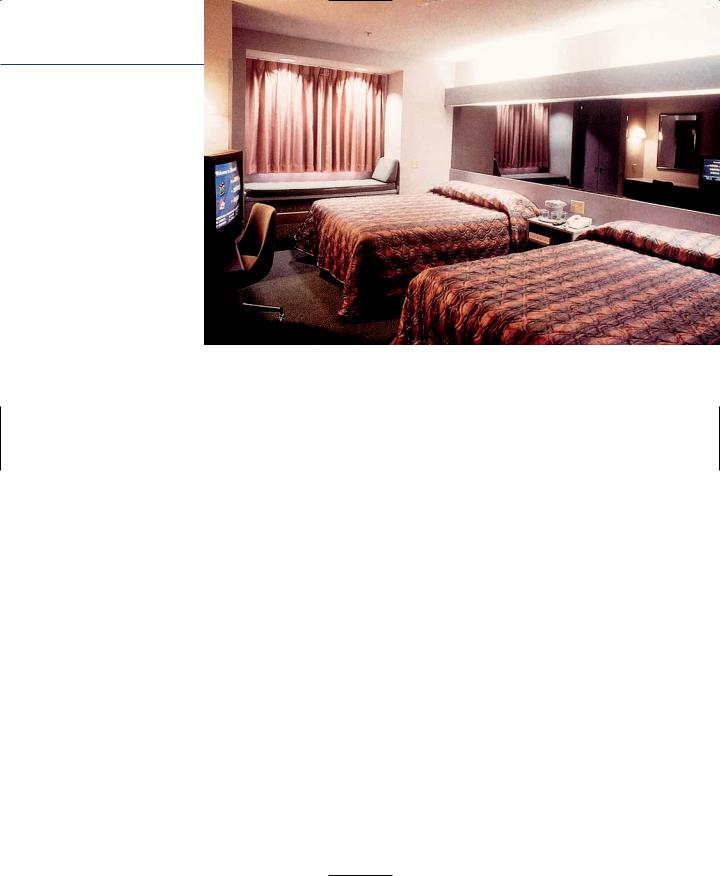
The flow of public funds into the lodging industry has been especially helpful to growth-oriented companies such as U.S. Franchise Systems and their Microtel brand, which is shown here. (Courtesy of U.S. Franchise Systems.)
a simple business again. We began to report our sales monthly including comps— “comparable” growth of sales at stores that have been open at least a year. When there are surprises, the stock reacts instantly. I think comps are not the best measure to analyze and judge the success of Starbucks. For example, when lines get too long at one store, we’ll occasionally open a second store nearby. Our customers appreciate the convenience and the shorter lines. But, if, as often happens, the new store cannibalizes sales from the older store, it shows up as lower comps, and Wall Street punishes us.38
Case History 11.1 describes the experience of Sam Barshop, founder of La Quinta Inns, as that publicly held company became the target of a takeover. There is a possibility, too, that having a significant portion of the industry in public hands, particularly those of REITs, where shareholder expectations are often focused on dividend yields, may pose some long-term problems to the stability of the industry. As one knowledgeable observer put it:
Historically, the hotel business has been cyclical in nature and characterized by widely dispersed ownership operating with a long-term development outlook. Considering Wall Street’s preoccupation with quarter-to-quarter growth and ever-increasing yields for shareholders, [the hotel business] would seem an unlikely choice [for public shareholders]. Whether these interesting times are ultimately viewed as a blessing or a curse will depend on how effectively our industry’s leadership responds to Wall Street and its fickle ways. A heavily consolidated industry may, in the end, prove a curse if the industry overextends itself and falls out of favor with the investment community.39
361
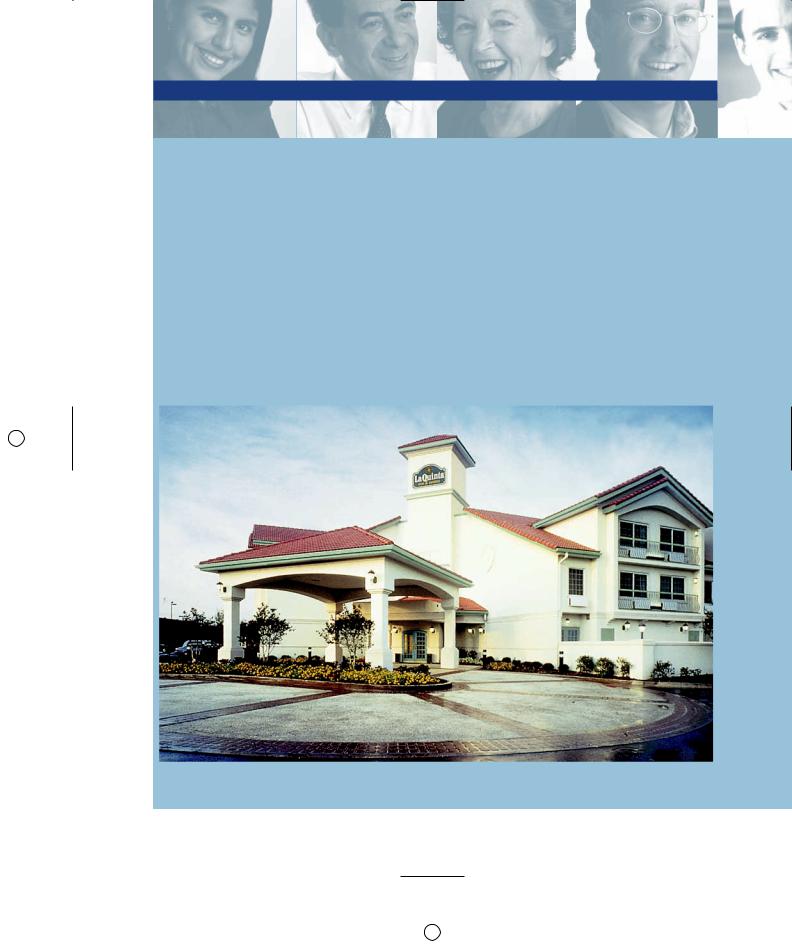
CASE HISTORY 11.1
Going Public: Some Good News and Some Bad
In 1968, the first two La Quinta Inns were built by Barshop Motel Enterprises in San Antonio, Texas, to serve visitors to the 1968 world’s fair, HemisFair.1 Although Sam Barshop had not intended to start a chain, the limited-service concept of La Quinta was so successful that he was approached by developers and investors, and soon his company began to expand. In 1973, in order to secure funds for expansion, the company went public. By 1978, ten years after the first inn opened, there were 56 inns in operation, with an occupancy of 90 percent. Another 19 inns were under construction. By the end of the 1980s, there were about 200 La Quinta Inns in operation.
In 1989, however, a Hong Kong firm, Industrial Equity, began to acquire shares of La Quinta, and by early 1990, it controlled 10 percent of the outstanding shares. Shortly thereafter, a second group of investors headed by two Texas financiers, the Bass brothers, began to acquire shares. In January of 1991, La Quinta hired Goldman Sachs, a New York investment banking firm, to explore ways to “increase shareholder value”—including the sale of the company.
However, at that time, mergers and acquisitions activity was depressed, as were La Quinta’s shares, by a recessionary stock market. La Quinta stock, which had been as high as $26, was selling in the $11 to
A contemporary La Quinta Inn. (Courtesy of La Quinta Inns.)
362

$15 range, and a suitable buyer for the company could not be found. La Quinta’s management spent an estimated $2 million in fees to attorneys, management consultants, advisors, and investment bankers in its fight to retain control of the company. The company’s operations and expansion were seriously compromised as executives spent time fending off what they saw as a hostile takeover bid.
Finally, in June 1991, an accommodation between La Quinta’s management and the dissident shareholders was reached. Five of La Quinta’s 11-person board were asked to resign, and new directors representing the Bass-led group (which by then owned 14.9 percent of the company’s shares) were elected in their place. Barshop’s supporters on the board retained five seats, and the eleventh seat on the board went unfilled. Working with the new board, the consulting firm of McKinsey & Company conducted a threemonth management study of La Quinta. As a result, the company was restructured, reducing its workforce by 72 people, 50 of whom were at the corporate offices. The company also took a $7.95 million restructuring charge, including $3.94 million for severances. At that time and shortly thereafter, several senior executives resigned. Then, in March 1992, Barshop turned over the presidency of the company to a former executive vice president of Motel 6, remaining as chairman of the board for another two years until he resigned in March 1994.
In June of 1991, at the time of the first compromise with the Bass-led group, Barshop had these comments on being a publicly held company:
There are a lot of advantages to not being a public company. You’re not responsible to the Securities and Exchange Commission or a large number of shareholders. You run your own business. You can focus on cash flow rather than earnings per share. . . . It’s been stressful. Business isn’t as much fun as it used to be. I’ve never dealt with anything like this before. Things aren’t done the way they used to be. I’ve learned more about proxies than I ever wanted to know. It’s been an interesting experience. But I hope it’s a one-time experience.2
Mr. Barshop ultimately lost control of his company, a company that by that time had 220 inns in 29 states. He sold 80 percent of his shares for $17.4 million and was paid something on the order of a million dollars during the last two years he served as chairman. Finally, we should note that he will go down in hospitality history as the man who invented the limited-service hotel.
1.This note is based, except as noted, on news stories reported in the San Antonio Express News, the San Antonio Light, and the San Antonio Business Journal, between January 1990 and March 1994; the June 1988 issue of Innput, an employee publication of La Quinta; and public statements by La Quinta Inns to its employees and the press. I would like to thank Mary Starling, secretary to Sam Barshop, for her assistance with the preparation of this note.
2.R. Michelle Brewer, “The Private Woes of Going Public,” San Antonio Light, June 16, 1991, pp. A1–A2. A contemporary La Quinta Inn. (Courtesy of La Quinta Inns.)
Update on LaQuinta Inn:
LQ Management LLC is one of the largest operators of limited-service hotels in the United States. The company operates and provides franchise services to more than 500 hotels in 40 states and Canada under the La Quinta Inn® and La Quinta Inn & Suites® brands. Their corporate headquarters is in Irving, Texas near Dallas. For more information on this brand, visit http://www.lq.com
363
